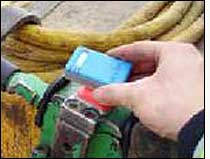British structural steel manufacturer Severfield-Rowen is among dozens of companies in the United Kingdom using an RFID-based system provided by Reactec to measure hand-arm vibration (HAV) among its employees, in order to help it comply with a European mandate limiting HAV exposure levels. Since the European mandate went into effect on July 6, 2005, construction firms have been tracking each worker’s exposure to the heavy vibrations of such mechanical tools as jackhammers, lawn mowers and drills. Overexposure can cause nerve or circulatory damage in a person’s hands.
Most companies require employees to manually write down and calculate the amount of vibration to which they were exposed, multiplied by the time of exposure. Now a group of RFID technology providers, including Reactec, have begun selling an automated alternative to companies that find paper-based tracking time-consuming and inaccurate. According to Mark-Paul Buckingham, Reactec’s managing director, the paper-based system typically inflates the amount of HAV exposure by 10 times when compared with Reactec’s automated technology. Most of the time, he maintains, workers use jackhammers and other power tools in short bursts, making it almost impossible for an employee to accurately calculate exposure, whereas RFID-based sensors can measure such levels to the minute.
Severfield-Rowen, Britain’s largest provider of structural steel, sought a useful solution to HAV tracking, according to the company’s health and safety manager, David Atkinson. The firm reviewed multiple products, then decided to give Reactec’s RFID-based system a trial run involving tests by select employees for several months.
The system consists of passive high-frequency (HF) 13.56 MHz RFID tags attached to each tool, as well as a HAVmeter, which contains an accelerometer and other sensors that can detect when a tool is in operation, and an RFID interrogator to receive data from the tool’s RFID tag. The tag complies with the ISO 15693 standard and was designed and supplied by CoreRFID. Each tag is encoded with its own unique ID number, in addition to the tool’s maintenance record, unique serial number and description, the level and source of the vibration, and other data, for use in the event that an audit trail is required.
At the beginning of a shift, Severfield-Rowen employees go to a Reactec base station, where multiple HAVmeters have been plugged into docks that connect the devices to the Reactec back-end system, as well as to a magnetic-stripe card reader and a keypad. A worker can either swipe his ID card’s magnetic stripe, encoded with his personal ID number, or use the pad to key in that number manually. The base station assigns one of the HAVmeters to that individual by linking its ID number to that of the employee, then illuminates a flashing light on the specific HAVmeter assigned to him. After taking his HAVmeter, the worker then proceeds to the work site and attaches the device, via a magnet, directly onto the RFID tag glued to the tool he is about to use.
The HAVmeter then reads the tool’s tag, which provides its unique ID number to the device, as well as other data including the level of vibration the tool is known to emit during operation. The HAVmeter’s sensors detect when the tool is being operated, then utilize a built-in timer to track the duration of each use. Upon switching to another tool, the worker moves the HAVmeter to that device. If an employee exceeds the safe level of vibration for a single day, the HAVmeter begins flashing a red light.
Once the employee is finished for the day, he returns the HAVmeter to its base station, which downloads data from the meter and routes it to Severfield-Rowen’s ERP system, where the Reactec software calculates the vibration exposure and displays a record of the tools that employee used throughout the day. In that way, the company’s management can determine, on a daily basis, the amount of vibration to which each worker has been exposed, as well as which tools have been used, how long they were in use, and when they may need maintenance.
“We discovered that the system was basically self-managing,” Atkinson says. “The fact that all data is downloaded from the [HAVmeter] automatically took the emphasis away from the employee.” He adds, “We had previously had a system where employees had to record, on paper, the times spent using vibratory tools.”
After completing the trial, Atkinson says, Severfield-Rowen fully deployed the Reactec system in the third quarter of 2008, attaching RFID tags to all of its angle grinders and needle guns—which remove rust from steel—along with various other power tools. Thus far, he adds, Severfield-Rowen has tagged more than 600 tools, and approximately 400 of the company’s employees use the meters on a regular basis.
In addition, the technology provided enables the firm to utilize the system as an asset tracker so that Severfield-Rowen management knows, for instance, which tool has been used in particular areas, and so that it can determine when additional tools need to be purchased, or when existing tools may require servicing.
Reactec currently has 62 clients using its RFID-enabled HAVmeter system, mostly in the United Kingdom, though Buckingham predicts there will eventually be interest throughout Europe and North America as well. Thus far, however, there is no legislation regarding HAV exposure in the United States.
One British construction company, Carillion, is employing a different RFID system, provided by Lancaster University, to monitor its workers’ exposure to vibrations (see U.K. Construction Company Works to Reduce Risk From Damaging Vibes). In this case, operators carry a badge that acts as an RFID reader, capturing an 802.14 Wi-Fi transmission from the tool’s tag. That data can then be downloaded to a base station at a vehicle parked at the work site.


